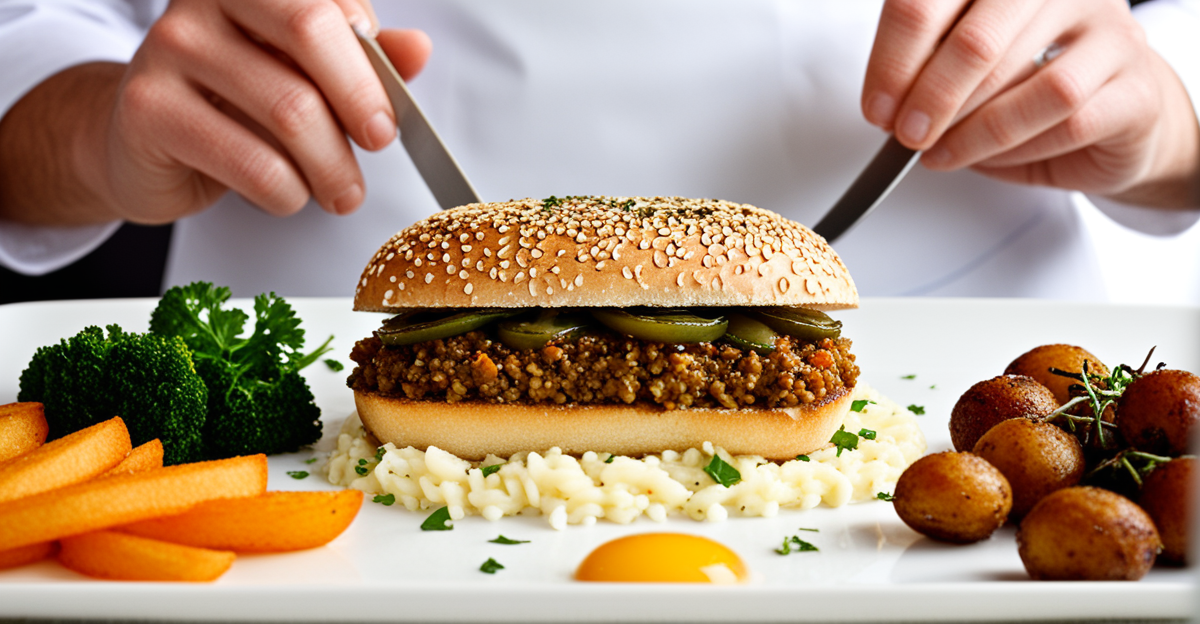Modernising British Cuisine: Approaches and Inspiration
Exploring British cuisine innovation involves carefully balancing tradition with creativity. Modern British food trends showcase how chefs revive classic dishes while respecting the heritage that defines them. Reinventing traditional dishes requires a deep understanding of their original flavors, alongside a willingness to experiment with fresh concepts and ingredients.
One key approach is incorporating both local and global ingredients. Using seasonal British produce maintains authenticity, while introducing international flavors can breathe new life into recipes. For example, herbs and spices from around the world enrich savory pies or roasts, enhancing without overpowering the base profile.
Topic to read : How can you make a flavorful Lancashire hotpot at home?
Culinary trends in the UK increasingly emphasize sustainability and provenance. This focus ensures that innovation in British food honors the land and culture it springs from. Chefs and cooks reinterpret traditional plates by tweaking textures, adding unexpected elements, or presenting dishes in innovative ways.
In essence, modernising British cuisine thrives on respectful creativity. It blends the familiar comfort of beloved dishes with contemporary influences, inviting diners to experience tradition reimagined — all while maintaining the soul of British food’s rich legacy.
Also read : How do you master the art of making a classic trifle?
Modernising British Cuisine: Approaches and Inspiration
Contemporary British cuisine innovation creatively reinvents traditional dishes while honoring the nation’s culinary heritage. Chefs emphasize the delicate balance between maintaining classic flavors and introducing fresh, imaginative elements that resonate with modern palates. This approach ensures that modern British food remains rooted in history but evolves alongside shifting tastes and dietary preferences.
Key to this evolution is the incorporation of both global and local ingredients. By blending indigenous produce with international flavors, British cooks expand their culinary repertoire without sacrificing authenticity. For instance, chefs might reimagine a traditional stew with locally sourced root vegetables but infuse it with spices or herbs inspired by other cultures. Such culinary trends reflect Britain’s diverse food landscape and celebrate its openness to global influences.
The heart of reinventing classic British dishes lies in respecting their original structure while exploring new textures, presentation styles, and flavor profiles. This fusion of past and present demonstrates that innovation thrives best when it builds upon a strong, familiar foundation. It allows British gastronomy to flourish with creativity, creating distinctive, memorable dining experiences that honor tradition while embracing change.
Modernising British Cuisine: Approaches and Inspiration
Innovating traditional British dishes requires a careful blend of respect and creativity. Today’s British cuisine innovation prioritizes maintaining the core identity of familiar recipes while introducing modern British food elements that appeal to evolving tastes. Chefs embrace culinary trends such as incorporating both local seasonal produce and carefully selected international ingredients. This approach allows traditional dishes to be reimagined without losing their signature character.
For example, classic British stews or pies might still feature indigenous root vegetables but gain fresh depth from exotic spices or herbs. This fusion does not overwhelm but complements, highlighting how global influences can coexist with authentic flavors. The balance between heritage and novelty is crucial; reinventing a dish does not mean discarding its essence but enhancing and adapting it thoughtfully.
The focus on provenance and sustainability also shapes these culinary trends, encouraging chefs to source ingredients responsibly while experimenting with textures, presentation, and seasoning. Reinvented traditional dishes offer diners a bridge between the comforting familiarity of British food and the excitement of new flavors – a hallmark of the ongoing evolution within modern British cuisine. This process ensures heritage remains a vibrant part of today’s food scene.
Signature Classic Dishes with a Modern Twist
Modern British food often celebrates traditional dishes reimagined through updated British recipes that blend heritage with creativity. For instance, the classic shepherd’s pie now features alternative proteins or a cauliflower topping, offering a lighter yet familiar experience. Similarly, fish and chips might be paired with inventive sauces or cooked using modern frying techniques to enhance texture and flavour.
Balancing authenticity with innovation is crucial. Chefs retain the core components that define a dish’s identity while introducing elements like fresh herbs or seasonal vegetables to refresh the profile without losing tradition. Techniques such as slow roasting or sous-vide cooking elevate familiar meats, ensuring tenderness and depth.
British food reinterpretation also emphasizes presentation—platting classic meals with contemporary style to appeal to today’s diners. This approach helps keep beloved comfort foods relevant, making them exciting yet recognisable.
By transforming beloved staples with thoughtful adaptation, modern British food exemplifies how updated British recipes continue to honor their roots while embracing culinary trends. This blend of respect and inventiveness ensures traditional dishes remain dynamic and appealing in both home kitchens and professional settings.
Modernising British Cuisine: Approaches and Inspiration
Current culinary trends in British cuisine innovation emphasize reinventing traditional dishes through a blend of respect and creativity. Modern chefs understand that traditional dishes reimagined must maintain the essence of British culinary heritage while adapting to contemporary palates. This delicate balance ensures that modern British food resonates both with nostalgia and novelty.
One key approach involves carefully selecting local, seasonal ingredients to preserve authenticity. At the same time, chefs incorporate global flavours subtly, enriching classic recipes without overpowering them. For example, a traditional roast might feature British root vegetables seasoned with spices inspired by international cuisines, creating a layered taste experience that honours the dish’s origins.
Maintaining this balance requires an in-depth knowledge of both historical British cooking techniques and emerging global culinary trends. The fusion of local and international ingredients allows chefs to innovate responsibly, ensuring that dishes evolve without losing their identity. This thoughtful process fosters growth in British cuisine innovation, inviting diners to experience tradition through a lively, contemporary lens.
Incorporating International Flavours and Fusion Elements
Fusion cuisine UK is a key driver of British cuisine innovation, blending international ingredients with traditional British recipes to create exciting new dishes. Chefs often incorporate spices, herbs, and flavour profiles from diverse culinary traditions, enhancing the classic British palate without overshadowing its essence. For example, using cardamom or cumin in slow-cooked British stews introduces warmth and complexity, while fresh coriander or lemongrass can brighten a traditional broth.
A prime example of British global fusion is the adaptation of fish and chips with Asian-inspired dipping sauces or spicing the classic Sunday roast with Middle Eastern herbs. These combinations respect the original dish while adding fresh elements that reflect Britain’s multicultural food landscape.
This approach allows traditional dishes reimagined with a global twist, keeping them relevant and appealing in a world where diners seek both familiarity and novelty. Fusion elements also encourage experimentation, pushing chefs and home cooks alike to explore beyond conventional boundaries. Ultimately, by weaving international ingredients into British culinary heritage, modern British food embraces diversity while preserving its foundational flavors, exemplifying the progressive nature of current culinary trends.
Modernising British Cuisine: Approaches and Inspiration
Modern British food reflects dynamic culinary trends where traditional dishes reimagined remain central. Reinventing classics requires deep respect for British culinary heritage while daring to innovate. This balance ensures that British cuisine innovation honors its roots without stagnation.
A key element in this process is the fusion of local and global ingredients. Seasonal British produce anchors the dish’s authenticity, while international spices, herbs, and flavours introduce subtle complexity. For example, a slow-cooked lamb shoulder—a hallmark of British cuisine—may be enhanced with Moroccan spices or Asian aromatics, adding depth without overshadowing the classic profile.
These culinary trends also emphasize adaptability, allowing chefs to tailor dishes for modern dietary preferences, such as reducing fat or incorporating plant-based ingredients, reinventing tradition with a contemporary lens. This approach fosters freshness while preserving identity.
Ultimately, British cuisine innovation thrives on this careful interplay between heritage and creativity. It is not just about new ingredients but about meaningful reinterpretations that deepen appreciation for traditional dishes, ensuring they remain relevant and exciting in today’s culinary landscape.
Modernising British Cuisine: Approaches and Inspiration
Contemporary British cuisine innovation revolves around reinventing traditional dishes reimagined while maintaining the soul of British culinary heritage. Current culinary trends emphasize balancing authenticity with creative adaptation, ensuring that modern British food respects the origins of classic recipes without stagnation. This approach fosters a dynamic evolution, inviting new flavors and presentations that resonate with today’s diners.
The integration of both local and global ingredients plays a pivotal role in this reinvention. Utilizing seasonal British produce preserves a connection to the land and tradition, while thoughtful incorporation of international spices and herbs introduces exciting complexity. For example, root vegetables typical of a British stew can be complemented by aromatic flavors like cumin or coriander, enhancing the dish’s depth without diluting its character.
Chefs recognize that innovation must sustain the emotional and cultural ties to traditional fare. By retaining the essence of classic dishes and thoughtfully layering new elements, British food innovation honors its past while embracing a global, modern palate. This fusion of familiarity with freshness defines the ongoing transformation in modern British food and highlights the vitality of continually evolving culinary trends.
Modernising British Cuisine: Approaches and Inspiration
Current British cuisine innovation revolves around the artful reinvention of classic dishes through evolving culinary trends. Chefs today focus on preserving the integrity of traditional dishes reimagined, ensuring that their core essence remains intact. A central challenge is balancing time-honoured British culinary heritage with the freshness of modern British food techniques and ingredients.
This balance is achieved by blending local and global ingredients. Locally sourced, seasonal produce forms the foundation, anchoring dishes in authentic British taste. Meanwhile, carefully selected international flavours subtly enhance these recipes without overwhelming them. For example, a traditional beef stew might incorporate spice blends from abroad, adding complexity while respecting its original heartiness.
Moreover, these culinary trends emphasize sustainability and provenance, which shape ingredient choices and reinforce heritage. Through this thoughtful fusion, innovation enriches British cuisine rather than replacing it, inviting diners to experience familiar flavours with novel, engaging nuances. In essence, British cuisine innovation is a dynamic interplay between reverence for tradition and confident experimentation, paving the way for vibrant, contemporary food culture.
Modernising British Cuisine: Approaches and Inspiration
Current British cuisine innovation builds on traditional dishes reimagined by blending respect for heritage with inventive flair. Contemporary culinary trends prioritize maintaining authentic flavors while introducing diverse elements, ensuring that modern British food resonates with both nostalgia and novelty.
A key factor is the balanced use of local and global ingredients. Seasonal British produce anchors dishes in familiar territory, preserving culinary roots. Meanwhile, careful inclusion of international spices and herbs adds complexity without overwhelming classic profiles. For example, traditional stews may incorporate cumin or coriander, enriching flavor layers while retaining their core identity.
Chefs today emphasize deep knowledge of traditional techniques combined with openness to global influences. This fusion enables thoughtful innovation where dishes evolve yet remain recognizably British. Reinventing classics involves subtle adaptations—adjusting textures, enhancing seasoning, or refreshing presentation—to appeal to modern palates and dietary preferences.
Ultimately, successful British cuisine innovation depends on honoring the foundational elements of beloved recipes while embracing creativity. This approach fosters a dynamic culinary landscape where tradition and progress coexist, making modern British food both rooted and relevant in a changing gastronomic world.











